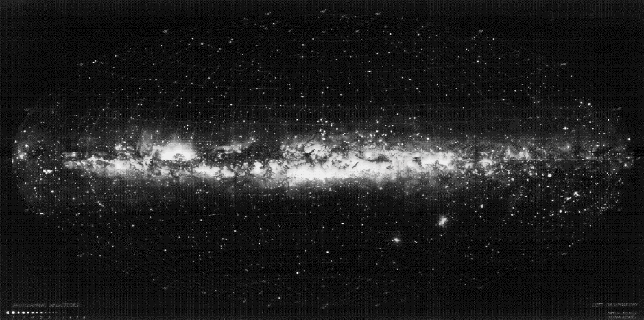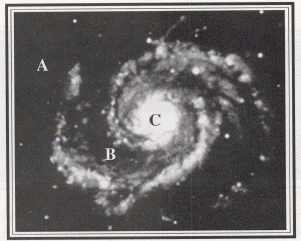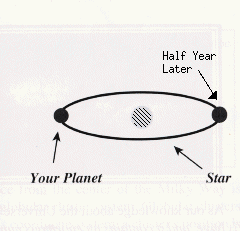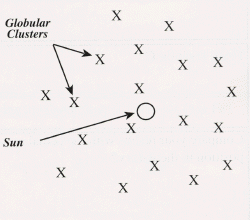Now SUPPOSE that your solar system is located at one of the positions (A, B, or C) on the image. In the following questions, describe what the night sky (say, at midnight, when your side of the planet is facing away from your star) would look like during the course of a year. In all cases, assume that the orbit of your planet lies in the same plane as the galaxy. Remember, as your planet orbits around its sun (see right-hand figure), the objects you see in the night sky would change. Also remember that the galaxy is flat (like a plate), with a spherical (ball-shaped) bulge of stars in the center.
(Start by assuming that your planet is on the side of your star that is away from the center of the galaxy. At midnight, you can see the part of the sky away from your sun. Would the stars you see be evenly distributed in the sky, or would there be a concentration of some kind? If so, would the area with lots of stars be circular, a band, or some other shape? Will there be many or few bright, nearby stars? How will the night sky change when your planet is on the opposite side of its sun?)
EXAMPLE: Sky seen from Position A during the course of a year.
At midnight, you will be able to see the part of the sky away from the Sun. So when the Star is between your planet and position C (the galaxy's center), you will see almost no stars in your night sky. You might see some randomly distributed halo stars and globular clusters. When your planet is between your star and the galactic center, you will see a large number of stars, mostly in a faint band across the sky (although you may see halo stars and clusters that don't lie in this band). This band may contain dark dust lanes. You may or may not (due to the dust) be able to identify the bulge of stars at the center of the galaxy. There will be very few bright, nearby stars in your sky at any time.
When your Star is between your planet and position C, you will see a faint band of stars in your sky, due to the spiral arm which is outside of your star's position in the galaxy. When your star and planet have reversed positions, you will see many more stars in a band along the sky, but the band may be somewhat brighter, if there is not too much dust. If there is a lot of dust in the disk of this galaxy, the difference in brightness may not be very great. Since you are inside the disk (and not at the outer edge), you will probably see some bright, nearby stars at all times of the year (more or less randomly distributed).
During the year, you will always see lots of stars in ALL directions (not just in a band). You may still be able to pick out a band which contains slightly more stars (depending on how much dust there is), but it will be much less obvious. There will be more bright, nearby stars than in the previous two cases.
Compare your results with the actual appearance of the sky
(This is a composite map of the total sky in ALL directions)
No. Many of the stars lie in a band of light. We see groups and clusters of stars.
We are not at the center, because we don't see stars randomly distributed in all directions. We are most likely partway off to one side (B), because 1) we see nearby bright stars year-round and 2) there is not a time of year when we do not see the band of stars from the disk of our galaxy.



